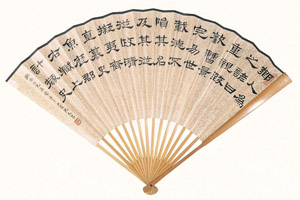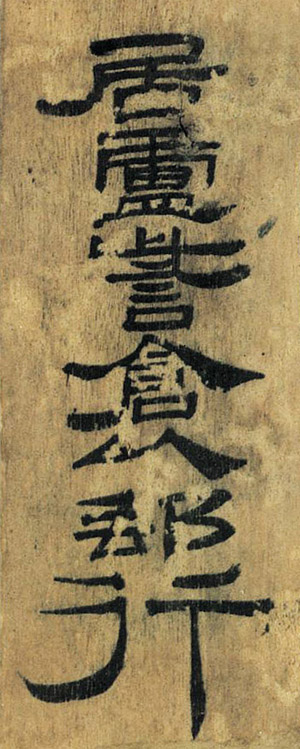Origin and Development of Categories of Calligraphy and Appreciation and Analysis of Calligraphy
Chinese calligraphy consists of five categories of seal script,、clerical script,、cursive script,、
running script and regular script.
Clerical Script
Legend says that for speeding up writing, Cheng Miao of the Qin dynasty turned the circular and balanced form of strokes of seal script into one of regulated and angular strokes, thus explaining the birth of the clerical script.
The most apparent feature of the clerical script is that the beginning of horizontal lines is akin to the head of a silkworm while the finish is akin to the tail of a wild goose and that its form appears flat and square, as if the characters were gliding in the sky. In the Han dynasty, almost all official documents were written in clerical script. In the Eastern Han dynasty, steles were also mainly carved in clerical script. The emergence of the clerical script ended the era of ancient writing that had spanned nearly two thousand years, while opening a new generation for calligraphic art which looked for beautification.
*Selected Works
| Before the invention and later popularization of paper, slip and fabric were the two major writing materials. “Slips” are long and narrow-shaped bamboo chips chipped for the use of writing. The Characters of Han slips represent the process of development from seal script to clerical script. They differed from the later mature clerical script in styles in both the combination of structure and the use of the brush. Some characters on this piece of Han slip, for example “ju” and “cong”, are shaped in flat and square form and, at the same time, give a lift in the pressing stroke, demonstrating the evolution towards maturity of the clerical script. | |
| Slips of Han dynasty |
|
 |
|
| Copy of Cao Quan Stele. Shen Yunchang (1912 - ), Republican Period |
Cao Quan Stele, set up by Cao Quan, chief of Heyang in the second year of the reign of Zhongping of Eastern Han dynasty (185). Text of the stele records the family background of Cao Quan and his achievement in suppressing a rural uprising. The calligraphy runs smoothly in light air, styled in classical elegance and structured in formal balance, representative of the orderly style of the clerical script of Han.
 |
|
| Copy of Xixia Eulogy. Zheng Jiaoxu (1912 - ), Republican Period |
The Copy of Xixia Eulogy, written by Chou Jingwen and put into calligraphy by Han De, stands on the cliff of Mount Tian Jin in Cheng county in Gangsu province. The text of the stele glorifies the incident of provincial governor Li Xi controlling the middle way of Xixia. The structure of the characters of the calligraphy appears in a systematic and orderly manner, conveying a grandiose style of stability.
In the learning of the writing of clerical script, one could firstly approach Cao Quan Stele in order to fully sense the qualities of flatness, broadness and elegance essential to clerical script. Subsequently, one could copy the steles of Xixia Eulogy, etc for sensing the unique flavor of the austerity and sobriety of the Han stele. One may then learn to trace the characters on Han slips for acquiring a natural use of brush. For long, many calligraphers have copied works of ancient clerical script and then made their own creations by adopting styles and technique of ancient works.




